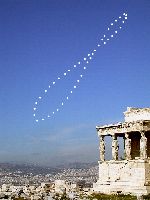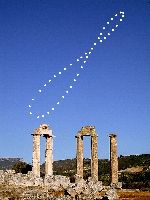|
The
solar analemma
|

|
|
The
analemma of 13h UT over the ancient Erechtheion. |
Text
and pictures by Anthony AYIOMAMITIS
The
weather factor (V)
The
Internet is a great resource for weather conditions and forecasts.
My preference during the duration of this project was Weather.com
which not only provides hourly forecasts for both the current and
the following day, in addition to a ten-day forecast, but also permits
for a subscriber to receive daily weather reports via email.
The
online forecasts really proved their value during my first set of
analemmas when heavy rains lasting a whole day had been predicted
for Nov 22/01 as far back as a week earlier and which, regrettably,
happened to coincide with my shooting schedule whereas the same
forecast had been consistently predicting totally clear skies for
the previous day (Nov 21/01) and partially clouded skies for the
following day (Nov 23/01). Monitoring the weather and the associated
forecasts up to the very early morning of Nov 21/01, I decided to go
ahead and advance my complete shooting schedule by one day as a
"preemptive strike" so as to be safe than sorry.
Fortunately, this proved to be a very wise and propitious decision
as the weather forecast was dead accurate for both Nov 22 and Nov
23/01!
The
online forecasts
Yahoo
Weather (World) - Reading
(U.K.) - Meteo-France (F)
However,
my incessant checks with weather forecasts would go against me for
the most critical exposure of all, namely the Aug 30th cross-over
point during the second marathon. If one were to check the ephemeris
of the sun on April 12 or 13th (spring cross-over) and compare it to
the ephemeris for Aug 30th (late summer cross-over), he/she would
note that azimuth and altitude do not match up precisely (the latter
is the preferred between the two). This deviation takes on a greater
significance if the analemma is initiated at the start of the
calendar year - the case for this set of analemmas - since it makes
sense to forego the spring cross-over exposure and pursue the late
summer exposure.
This
rolling of the dice, however, namely that weather on Aug 30th
will be suitable for imaging without any backup
or supplementary exposure possible if the weather will not
co-operate, proved to be a mistake. Weather forecasts on Aug 28 and
early morning on Aug 29, 2002 persistently indicated three-day
thunderstorms starting during the very early morning hours of Aug 30th, 2002.
With
much hesitation, the decision was made to image on Aug 29, 2002 so
as to circumvent the anticipated storms the following day (had the
forecast not indicated that the storms would last for three days, a
decision would have been made to risk imaging as much as possible on
Aug 30, 2002 and, if necessary, supplement any missing exposures on
Aug 31, 2002 since supplementary exposures a day early (Aug 29) or a
day late (Aug 31) are, in essence, the same). Of course, the weather
on Aug 29, 2002 was less than ideal (thin clouds throughout) whereas
the three-day forecast involving thunderstorms was completely
off-base as pristine conditions characterized most of Aug 30, 2002.
The thin clouds on Aug 29, 2002 fortunately did prevent the imaging
of three of the analemmas (13:28:16, 17:00:00 and 18:00:00 UT) which
were shot as originally scheduled on Aug 30th (13:28:16 UT analemma)
or two days later (17:00:00 and 18:00:00 UT analemmas)!
By
way of conclusion
The pioneering work on the photography of the analemma by di
Cicco (S&T, June/79, pg. 536-540) involved an unsuccessful first
attempt at capturing the analemma due to the sun partially eluding
the initial field of view. Regrettably, a similar outcome
materialized with this project where the first six months of imaging
(June to Dec 2001) had to be discarded due to a missed exposure
which could not be substituted with an exposure a day or two
earlier/later due to heavy clouds and rains over a period of about
two weeks. Nevertheless, this failure did provide the foundation for
a restart that would be uniquely characterized with imaging across
one calendar year in lieu of twelve consecutive months spanning two
years which is characteristic of each of the other successful
analemmas to-date.
|

|
|
The
analemma of 14h UT over Zeus' Temple, ancient Nemea. |
A total of 473 multi-exposures (11 analemmas with 43 images
each) were originally planned during the 2002 calendar year so as to
generate the analemmas depicted in Figures 3 to 13 and the composite
graphic in Figure 14. Of these, a few dozen only were substracted
due to physical obstructions that could not be circumvented in any
way.
The analemmas in Figures 3 to 13 and
associated breakdown is not only a graphic illustration of the
sun's movement across the local skies during one calendar year but
also represent the physical characteristics and climatic conditions
of the immediate region; the latter is something which became
obvious as the project progressed and was reinforced by the need for
a restart. A published report in one of the local newspapers on Feb
1/02 indicated that Oct/01 was the fifth driest October since 1927,
Nov/01 was the fourth wettest November also since 1927 and Dec/2001
was the third coldest December since 1896 - dubious records which
significantly impacted the initial part of this marathon and led to
its premature end and consequent restart.
Check
the tables in the appendix
The analemmas described and presented in this article do
indeed represent a most challenging and rewarding exercise requiring
dedication, patience, perseverance, thorough advance and detailed
planning, a (great) sense of humor (vis a vis numerous accidental
film advances as per the earlier discussion), constant interaction
with weather web sites as well as some degree of good fortune with
the local weather and other intangibles such as unobstructed views,
unforeseen problems with cameras, lenses, filters, batteries and
mounts. Nevertheless, this challenging exercise is something that I
intend to revisit immediately using various special photo techniques
I have in mind and briefly alluded to above.
Yes, Mr. Di Cicco, I am nuts and I painfully have a complete
set of incriminating photos from Apollo's paradise to prove it!
About
the author
Having
successfully managed to retire very early, Anthony Ayiomamitis has
now combined his teenage interests of astronomy and photography into
a full-time preoccupation and addiction with the astrophotography
(film and CCD) of rare, bizarre, extraordinary and challenging
extra-terrestrial events. When not in hot pursuit of such eccentric
astrophotography projects or touring and imaging ancient Greek ruins
and mythical sites, he can be reached through his website Perseus.
Of course, with the additional analemmas now in progress, the
construction of his home observatory is on-hold yet again for
another year!
The
analemma pictured at 6h UT was published on APOD on March 20, 2003
as well as in the U.S. "Astronomy Magazine". It was
elected "Photo of the year" by the british magazine
"Astronomy Now" who published it in its annual calendar
2004. The analemma pictured at 10h UT was published on
Spaceweather.com during several days from September 20, 2004, LUXORION
receiving the exclusivity for publishing all author's works related
to this project.
Ce
document est également disponible en français.
For more information
Anthony Ayiomamitis's
website (Perseus)
Analemma.com
Steve
Irvine
BHM
website (in danish)
Jürgen
Giesen (sundials and analemma)
David
Przewozny (in German)
Analemma
on Mars (APOD)
I warmly thanks Anthony Ayiomamitis for his participation.
|